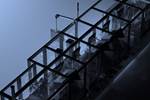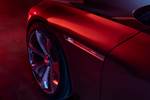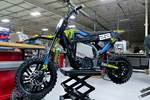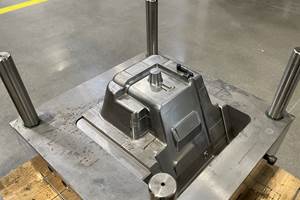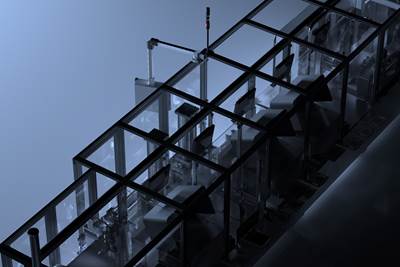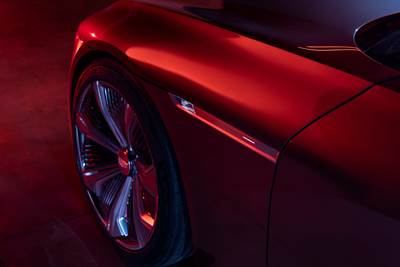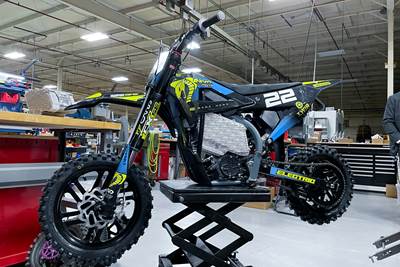Manufacturers of electric vehicles (EVs) seem to be adopting additive manufacturing (AM) more readily into production than the conventional automotive industry and other transportation segments have. This adoption is in part because of the functional and geometric possibilities that additive brings, but it is also because EVs are being made in lower quantities and represent new product platforms without existing supply chains, tooling and processes to contend with. In this episode of the AM Radio podcast, Julia Hider and I discuss various ways that AM is and could be used to advance the future of transportation based on electric vehicles.
Transcript
Stephanie Hendrixson
Electric vehicles are on track to change transportation and additive manufacturing is along for the ride. Today we're going to talk about how AM is enabling EVs. That's coming up on AM Radio.
Julia Hider
The AM Radio podcast is brought to you by the Additive Manufacturing Conference at IMTS. The leading industry event focused on 3D printing for production. Learn more at AdditiveConference.com.
Stephanie Hendrixson
Welcome to this episode of AM Radio. I'm Stephanie Hendrixson. I'm here in the studio today with Julia Hider. Hi, Julia.
Julia Hider
Hey, Stephanie.
Stephanie Hendrixson
So today we have kind of a big sprawling conversation planned. We're going to talk about electric vehicles, or EVs, and additive manufacturing.
Julia Hider
Yeah. So over the past few months, Additive Manufacturing Media has been focused on electric vehicles and we built a microsite you can find that at GBM.media/AM4EV, that's the number four. That is sort of a landing page for all of the EV content that we've been putting out. But there are articles, there are webinars, and we're going to go through some of that today.
Stephanie Hendrixson
Yeah, so if you want any more information about some of the things we talked about, definitely check out that microsite. And we'll drop a link in the show notes as well. But I think we should just sort of start off by talking about why we're seeing additive manufacturing kind of find its footing and start to take off in some of these electric vehicle applications. And we should say that EVs, we're talking about more than cars here, but I think maybe it's helpful to just start with cars. So Julia, what kind of car do you drive?
Julia Hider
Yes, I drive a Honda Civic.
Stephanie Hendrixson
Alright, so very popular car. I just read that it is one of the most stolen cars in America, but also very popular to buy.
Julia Hider
Probably why it's the most stolen car, I will make sure to lock my car diligently.
Stephanie Hendrixson
But that is a really high volume, like consumer mass market car. As far as I know, unless you've left some sort of tradeshow giveaway inside of yours, there are no 3D printed components to your car.
Julia Hider
No, not as far as I know.
Stephanie Hendrixson
So you've been writing about additive for a while. And there are certain markets where it's pretty well matured and it's pretty well advanced, automotive, not necessarily one of them. Can you give us a couple of reasons why additive manufacturing hasn't made the inroads into automotive that it has in other industries? Like why are there no 3D printed parts in your Honda Civic?
Julia Hider
Yeah. So I would say that number one, volumes, like you said, the Civic is one of the most popular cars. So obviously, you need really high volumes of parts and additive probably isn't quite there yet reaching the volumes required for production of a Honda Civic. And along with that, I would probably say price, you know, the price point of a 3D printed part probably can't compete with a traditionally machined or cast or molded part yet.
Stephanie Hendrixson
Yeah, so I think that sums it up pretty well, like automotive is this industry that has like very large scales in some in some cases. The interesting thing, I think, is that additive manufacturing, we know it can make automotive parts, like how many Formula One teams are using 3D printing right now, it is physically possible, but at the scale that a Honda Civic requires additive manufacturing might struggle to keep up, it's probably going to be more expensive, especially if you're not changing anything about the design, like a 3D printed bracket that looks exactly the same as a machined bracket, it's probably just going to cost more just because of the nature of the processes, you have to be able to change something for additive to be able to add some value and justify its cost or bring its cost down. I think the other issue is that in the automotive industry, at least for like these really mass market cars, internal combustion engines, things that have been in production for a long time, automakers have really well established supply chains, they know where they can get a stamped part, or an injection molded part or a casting. And so it's really difficult for additive to kind of insert itself into that process. And there's not really a good reason to do it, if we already know how to make this car with the conventional techniques that are already out there. But electric vehicles are really exciting, I think, because we know additive manufacturing, does best when it gets in like on the ground floor, not just of a specific part design but have an entire system. And so even the established automakers, electric vehicles are new product platform, so getting rid of the internal combustion engine, you lose the engine, you lose the fuel tank, you have to think about cooling and different parts of the system differently. And then you also have like this big battery pack to contend with. And so additive manufacturing starts to look more attractive because you have maybe more space to play around with. It's really good for lightweighting which becomes important when you're trying to extend the range of these vehicles, and you're not locked into maybe those conventional supply chains. The other interesting thing is that there are a lot of startups in the EV market as well that are coming into this without any history of stamping and casting and injection molding and so there's not as much incentive for them to go to those conventional processes and there's maybe more opening for them to look at additive manufacturing.
Julia Hider
Yeah, we're definitely at an inflection point where additive manufacturing can make its way into the automotive industry, but before we really dive into this topic, I want to ask what counts as an electric vehicle because I know we're going to talk about some stuff that isn't necessarily what you would traditionally think of as a vehicle.
Stephanie Hendrixson
Right. So this is a conversation we had to have to create the microsite because if you only limit to cars, like cars are a really important EV space right now, but really an electric vehicle could be any type of vehicle that's using electric motors or electricity for propulsion. So it could be stuff like those electric scooters that people leave all over the sidewalk. It could be like trolleys and trams, including like the Cincinnati streetcar, what is it called?
Julia Hider
The Cincinnati Bell Connector.
Stephanie Hendrixson
Yeah, including the Cincinnati Bell Connector that we have here in the city that has like the overhead electric lines, like that's an EV. It could be unmanned aerial vehicles, unmanned underwater vehicles, like things that are more like drones, even like crazy stuff like those electric vertical takeoff and landing EVTOL helicopters, like anything that's using electricity as its main source of propulsion. And like, arguably, you can put hybrids into this category, too. They have the internal combustion engine, but they also have the battery. I drive a hybrid, so I'm okay counting it as EV, sort of. So lots of different types of vehicles fall into this category. There are also lots of different types of components that we're seeing being 3D printed, everything from batteries to, like structural parts of the car, like brackets and things like that. Heat Exchangers, motor windings, everything down to like little aesthetic touches, custom cupholders and stuff like that. But let's talk about some specific examples. And I think maybe the way to do this is to kind of take it by materials and maybe look at some polymer examples, a couple of metal examples and then if we can come up with a couple others.
Julia Hider
Sounds good.
Stephanie Hendrixson
So let's, let's just start with metal. What are some examples of 3D printed metal components that we've seen for EVs?
Julia Hider
Yeah, let's talk about metal. I think the most famous or well-known example of a metal 3D printed automotive part is the GM seat bracket. It's from a few years ago, 2018, 2019, I think, and GM worked with Autodesk on this generatively designed metal 3D printed seat bracket, and it's 40% lighter and 20% stronger, and it consolidated and eight-piece assembly into one part.
Stephanie Hendrixson
Yeah, I remember this bracket. It was, it was everywhere, when it came out. And like this is exactly the kind of thing that we're talking about, like additive manufacturing, to replace an existing bracket, probably not going to be a win. But when you can do stuff, like consolidate all those parts and make it lighter, again, like you're getting better range out of your battery, you're getting a better battery life, those sorts of things. But what happened with that bracket? Is that something that's being used, or was that sort of a test?
Julia Hider
Yeah, I think it was more of a proof-of-concept part. GM wanted to sort of think about some of the challenges of AM, rethinking workflows and how to test the parts.
Stephanie Hendrixson
Okay, so so that bracket is not something that has gone into production, I actually did recently see an example of a brackety kind of thing that is going into production. It's the A pillar for a convertible. And it's 3D printed and has this really like crazy generative design sort of look to it. I don't think it's going on to an electric vehicle. But that is an example of a place where the lightweighting and the strength was important. And the scale is such that 3D printing can deliver these parts. So even though it's not an electric vehicle, like a lot of the stuff that we're seeing happen in conventional vehicles could transfer over to EVs as well.
Julia Hider
Yeah, I have another example. That's sort of like that parts that were not for an EV. This was actually for a car that was for off road racing. So lightweighting and strength are important. It was for a car that Romain Dumas, who's a Porsche factory driver and founder of a racing team was driving at the Dakar car rally and they had Polyshape, which is a subsidiary of AddUp, 3D print some parts for the car. They had a 3D printed lever that had 60% less mass than the original. Again, some assembly consolidation they were able to embed a cable into the lever because of the 3D printed design. They also 3D printed the car’s pedals, so those are lighter as well, 42% lighter than the originals. Another interesting thing that they did was that they made the brake, which is the most used pedal, stronger than the other two pedals and they also put a special surface 3D printed surface that would increase the grip between the pedals and the driver's foot to prevent slipping. And then there was one last part which is a 3D printed exhaust ball joint that prevents the exhaust line bellows from breaking or catching fire during a race.
Stephanie Hendrixson
Seems important.
Julia Hider
Yeah, pretty important, I would say. It had two sliding layers that were connected with an interference fit that couldn't be manufactured any other way. And it can withstand, you know, high temperatures and pressures and these racing engines.
Stephanie Hendrixson
So those were really cool. And like, I think, you know, the point stands that we're talking about racing here. So like one car, we're talking about an internal combustion engine, still, but a lot of this stuff I think is going to eventually make its way into electric vehicles make its way into the mass market. I just want to make the point that we're not just talking about, like generative design and lightweighting. Like, there are some really interesting things that electric vehicles need or require that additive can can deliver. So an example is just like the way that you cool the car has to change. If you don't have fuel, you don't have as many like fluids and things to work with. Just keeping the car and its electronics cool, you've got to think about that a little bit differently. We actually have an episode of The Cool Parts Show coming up here where we've got a heat exchanger. Basically, they call it a cold plate for an electric race car. It was this car developed by a team of students at the University of Milan, and they worked with some different suppliers to design and create this like really cool looking heat exchanger. And that's the sort of thing like we're not seeing it at any sort of scale right now, at least not that I'm aware of, but it's it's a case, like some of the components you talked about with the race car where there's no other way to make this. And if you want those performance benefits, you're going to have to figure out or we as an industry are going to have to figure out how to 3D print it so that it's it's fast, and it's affordable, and it can be part of the this next generation of cars.
Julia Hider
Yeah, you actually brought this part into a meeting that we were having, just because it looks so cool. So I'm looking forward to learning more about it. So I think we've covered metal pretty well. I want to get into plastic and polymer. So do you have any examples of polymer parts that we can talk about?
Stephanie Hendrixson
Yeah, so earlier, we talked about how EVs are not just limited to cars, and I'm going to take us out of automotive with this next example. Earlier this year, I had a chance to go visit Cobra Moto along with our colleague, Pete Zelinski. Cobra is a really well-known manufacturer of motocross bikes for youth riders, kids that are often very competitive at this sport. And so up until this point, all of these bikes have had internal combustion engines, they've all been gas powered. And this year, they are releasing their very first electric bike. And so we got to see it while we were up there, they've been using 3D printing for a while, like they have a separate drone business and so they have a metal printer for that, they just recently added a Multi Jet Fusion printer. And when you look at this electric bike, it looks similar to previous generations of the bike, except that it has all these 3D printed parts on it. And when you start to look closely, you can see that it's missing some of the stuff that you would expect to see on a motocross bike. So, there's no fuel tank. Instead, there's this air diverter, which is 3D printed, which is just to like, direct air to cool the motor, and it's got various other Multi Jet Fusion parts on it. And if you just sort of look at it for a while, you start to see the 3D printed parts pop out.
Julia Hider
Yes. So it has all these 3D printed parts. But you know, 3D printing isn't the only way that they could have made these parts. So why did they decide to go with 3D printing?
Stephanie Hendrixson
Okay, yeah, so, so good question. Because they work with injection molders, they have a lot of other parts, plastic parts that are that are made that way. But for this bike, it was such a new product, they knew there was going to be a lot of iteration, they knew they were going to make a lot of design changes. They didn't want to go and just buy a mold immediately. They wanted the, the freedom to just sort of figure out, like, what, what is the right configuration of the fins and the air diverter, like stuff like that. And so they're using 3D printing, I think at first, it was sort of a go-to-market thing, like try to get this design locked in and this bike out into the world as fast as possible. But now it sounds like they may never go to injection molding, they might just stick with the 3D printed parts. And if the scale stays at a level that they can maintain, then it'll make total sense to just keep printing those components there. They're holding up fine. They're performing well. And they look good, too.
Julia Hider
Yeah, they do look good. That story is on the cover of our June issue. And I think it turned out really cool. So check that out if you haven't yet.
Stephanie Hendrixson
Yeah, we'll put a link to that in the show notes as well. Alright, so we've talked about metals, we've talked about some plastic components. These are all sorts of things that exist like around the thing that makes the car drive but we're also seeing examples of 3D printing being used to make batteries and like that could be really huge for electric vehicles.
Julia Hider
Yeah, so I recently wrote about a company called Sakuu who and they're developing a 3D printing platform for solid state batteries that can be used in place of lithium-ion batteries. Now lithium-ion batteries are the most common type of battery in EVs, but they have some shortcomings, the main problem being that they have this liquid electrolyte which has a tendency to catch on fire if they're damaged or overheated, so there's obviously a safety concern. Because these batteries have this risk, they have these, you know, safety systems around them to mitigate the risk, which adds extra weight on top of the batteries already being kind of heavy. Like I tweeted this, I don't have an electric vehicle, but I do have an electric lawnmower. And I didn't realize how heavy these batteries were until I got this lawnmower and I had to take the batteries out and charge them. And you know, I can only imagine if that's what's needed to run my lawnmower, how much heavier a lithium ion battery needs to be to power a whole car. So solid-state batteries are possible that uses you know, a solid electrolyte instead of a liquid, but they've proven difficult to manufacture. Dave Peterson, who is the Vice President of Marketing and Business Development at Sakuu he described a solid-state battery as like a sandwich or a layer cake with the solid electrolyte in between the anode and the cathode. But the challenge is that you're working with really thin sheets of material like 20 or 30 microns thick. And it's difficult to you know, handle that and ensure that the, you know, surfaces are interfacing and they're touching properly. So what Sakuu is doing is developing a platform that can just 3D print the solid state batteries and build them up so that all the layers are interfacing properly, and you don't need to handle thin sheets of material. And in order to do this, they developed a multi-material, multi-process 3D printing platform called Kavian. It combines a binder jetting type process for larger areas, and then material jetting for finer details. It can do a whole bunch of materials like ceramic, glass, metals and polymers in a single layer. One of the biggest challenges with that is material compatibility. And the company had to do a lot of work to ensure that all of the materials were working together from printing all the way through to sintering. And one of the bonuses is that combining all these processes into one platform speeds up production, especially because they can run some of the processes at the same time in parallel. So that'll be really key for the high volumes in the automotive industry. And all of this is still in development. And I also think it'll be interesting to see, you know, what this platform could be used for besides batteries, because it's multi-process, multi-material, 3D printing, and there are a lot of broad applications for that.
Stephanie Hendrixson
Yeah. So that's, that's consolidation on a lot of levels, all those different materials coming together those different processes coming together. I've seen another example of 3D printed batteries, but really, they're sort of focused on the electrode. So like, how do you combine the anode and the cathode like you're talking about? So Photocentric, I know is working on this, and maybe some others are, too. But in their case, they're focused on digital light processing, DLP, and they use special resins where the electrode material is like powdered, and it's inside the resin. And so you, you can print with that, but then you need to debind it and center it. But again, like the consolidation that you can do, the fact that you can make a battery that's maybe the same size as your existing battery, but it has more power, it has more range. I think the other thing with 3D printing is that these battery packs take up a lot of space. Like if I look at my hybrid, the entire car is built around accommodating that, that big heavy battery. And so if you could 3D print it, it could be maybe different shapes, or it could be configured in a way that would leave more room for cargo or for legroom or, you know, whatever you might want in your car or other EV. So we've been talking about like some really specific part examples that we've seen on EVs. But I do want to talk about sort of the bigger impact like what effect is additive manufacturing going to have on EVs and transportation overall?
Julia Hider
Yeah, let's talk about that after the break.
The AM Radio podcast is brought to you by the Additive Manufacturing Conference at IMTS, the leading industry event focused on 3D printing for production co-located with North America's largest trade show dedicated to manufacturing equipment, the AMC takes place September 14 and 15 at Chicago's McCormick Place. The conference takes a practical applications-based look at the machines, materials and methodologies being used to 3D print functional components, including both tooling and end use production parts. The event is designed for owners, executives and engineers, as well as OEMs involved in durable goods manufacturing, join the Additive Manufacturing team in Chicago for a day and a half of conference sessions and networking opportunities. Find more information and register at AdditiveConference.com.
Alright, we're back. I'm here with Stephanie Hendrixson. And we've been talking about electric vehicles. And the first half of the show, we sort of talked about some specific examples of 3D printed parts that are going on to electric vehicles and other vehicles. But in this half of the show, we're going to talk more about the big picture of additive manufacturing and electric vehicles. Stephanie, what are some examples of how this fits in right now?
Stephanie Hendrixson
Yeah, so big picture like there are short term things to talk about. And I think we can use that as sort of a jumping off point to talk about the long-term things, but starting with like what's going on right now, earlier this year, I had a chance to visit this company called Extol, they are on the west side of Michigan. So still kind of in the automotive industry, that is a big part of what they serve. And while I was there, Andrew Roderick, who is the senior applications and sales engineer, made this comment that vehicle design cycles have gotten much, much more fast and short. Like it used to take an automaker maybe four years to design and release a new car. Now that cycle is down to something like two years. And so that's electric vehicles, it's also conventional ICEs. But that just sort of highlights the growing importance of additive manufacturing for bridge production, and like the test drive market, so a lot of what Extol is doing, and they previously were not manufacturing plastic parts, they're really good at joining parts together, and so previously, they would have been getting like batches of injection molded parts, and they would like ultrasonically weld them together, or heat stake them or do other processes to join these pieces. Now, they have a couple of their own printers, and they're manufacturing these parts. And a lot of what they're doing is essentially functional prototyping or bridge production, they're making parts that are going to go into test tracks that are going to go into like early run vehicles. And it's partly because these timelines have been compressed so much that there's no more time to like wait for a mold to get made, there's no more time to risk the fact that you might buy a mold. And it might not do what you need it to do if you're trying to get these cars into testing into consumers’ hands or garages as quickly as possible. So it's very similar to what we're seeing with Cobra where 3D printing is this way to really quickly iterate designs and then to start to produce the parts before you invest in the tooling. Or maybe you never invest in the tooling at all. So over the long term, I think there are going to be a lot of implications for the supply chain as well.
Julia Hider
Yeah, you know, you talk to your examples of tooling were all related to polymer, but I have one that's related to metal. I recently visited a company called Alloy Enterprises. And they've developed this process called selective diffusion bonding, which is a form of sheet lamination for aluminum. So they talked about increasing demand for aluminum with electrification, because it's both strong and lightweight, you know, it has a strength to weight ratio that's twice that of steel. And it's infinitely recyclable. So really great material to work with. But there are supply chain difficulties in getting large volumes of aluminum parts because the traditional process is casting, and that requires tooling. But as far as additive manufacturing for aluminum goes, there's not really a process that's designed specifically for aluminum. So they started looking at this problem, and they decided that they wanted to get away from powder. And they invented this novel aluminum feedstock. It uses the same aluminum rolling process that's used for aluminum foil and soda cans. So they take this feedstock, they laser cut it, they apply an inhibiting agent to certain areas of the material to create supports, stack up the sheets, bond them and then you break away the supports and expose the parts. So they say that's good for you know, electric vehicle components like enclosures, electronics, parts with cooling channels and margin modular parts that you don't want to invest in tooling for.
Stephanie Hendrixson
Yeah, so, so that's like compressing the supply chain by avoiding casting, avoiding the tooling that you need. Getting to the parts faster. I think this can even go further than that. Another company that I visited recently was GKN Additive. They have a new facility in Auburn Hills, Michigan, again, really close to Detroit. They want to be close to their automotive customers. And most of what that facility is doing is actually electric vehicle parts. So GKN is this company that has a really long history of metal part production, mostly like press and sinter and MIM, metal injection molding, but a couple of years back, they bought Forecast 3D, which is a California-based, like, a contract manufacturer or service bureau that has just like a huge fleet of HP Multi Jet Fusion printers. So they know polymers really well. And they also understand sort of like that high mix, low volume marketplace, that additive is really good at and so GKN acquired Forecast 3D, they formed this, this organization that's GKN Additive. And part of what they're trying to figure out between those two locations in California and in Michigan is how do we do distributed manufacturing? Like how do we move the production close to the customer or close to the expertise or to the place that has the right material or the right equipment? And so like this is kind of my point, when I say like let's talk about the big picture, additive manufacturing, it's not just going to change the way we make seat brackets and batteries and stuff like that. It's also going to change where we make parts for these vehicles, and also probably the kinds of vehicles that we make. Earlier you mentioned our microsite and these webinars that we did. There are two out there. They're, they're available on demand, you can watch them, I moderated them both. And inside of one of those presentations, there was an expert there from this company called Pix. It's p-i-x. It's a self-driving company that has developed what they call the ultra skateboard chassis. It looks like a big skateboard, like it's the four wheels of vehicle and then sort of like this platform where the battery and all the electronics and stuff live. And then you can build whatever sort of pod on top of it that you need. So it could be everything from like, a little autonomous, like food delivery robot up to like a moving van or something like that. And so you can get these chassis is in like, whatever size you need. And you can build whatever you want on top of that. And part of the way that they're able to offer this is because they use 3D printing, specifically, wire arc additive manufacturing, or WAAM to print the chassis out of aluminum, like we were talking about that being a popular material. And then you can make these skateboards in whatever size whatever configuration that you need. So this is an example of additive manufacturing maybe is not going to get to the Honda Civic mass market, but it can absolutely do weird and custom and unique things like this on the kind of scale that these vehicles might be required in.
Julia Hider
Yeah, I watched that webinar, it was really cool. It was really forward thinking I was really excited by the idea of an autonomous vehicle, so you don't have to drive it. And maybe I could catch up on Netflix or something while I'm commuting.
Stephanie Hendrixson
I know yeah, that's, that sounds great. But here, again, like Pix is another of these companies that they're proving out the technology, but like ultimately, they'd love to build micro factories, they'd love to be able to make these skateboard chassis close to the people that are going to then put pods on top of them and close to like the cities and locations where they're going to be used. So I think like that is an example of some of the really exciting things that are coming in the future, like additive manufacturing has all this capability. It's been really constrained as far as its entry into like the conventional automotive market. But electric vehicles and not just cars, electric vehicles of all sorts are opening these new possibilities. And when you start from a blank slate, like we've seen in other places, additive manufacturing can really take off and provide a lot of benefits when it is kind of there from the ground level as I think it's going to be for EVs.
Julia Hider
Yeah, this was a really wide-ranging conversation. We covered a lot related to EVs and additive manufacturing. We'll have links in the show notes to all of the articles that we've referenced, and I think most of them are on our microsite that we mentioned earlier: GBM.media/AM4EV.
Stephanie Hendrixson
Yeah, so check those out. If you liked this episode of the show, make sure to subscribe to AM Radio on your favorite podcast platform, so you'll be notified about all of our new episodes. If you'd like give us a five-star rating on the platform of your choice. Tell a friend, tell a colleague about us. Thank you for listening.
Julia Hider
AM Radio is recorded with help from Austin Grogan and Seth Cooper. The show is edited by Alex Lytle and Stephanie Hendrixson. Our artwork is by Kate Bilberry. AM Radio and Additive Manufacturing Media are products of Gardner Business Media located in Cincinnati, Ohio. I'm Julia Hider. Thanks for listening.
Related Content
BMW Group Vehicle to Adopt 3D Printed Center Console
A vehicle coming to market in 2027 will include a center console carrier manufactured through polymer robot-based large-format additive manufacturing (LFAM).
Read More8 Cool Parts From Formnext 2024: The Cool Parts Show #78
End-use parts found at Formnext this year address various aspects of additive's advance, notably AM winning on cost against established processes.
Read MoreDaimler, OMIC Evaluate Wire-Fed DED for Moldmaking
3D printing a core and cavity on machine from Gefertec, followed by machining, allowed for a complete mold tool to be produced in three days.
Read MoreVideo: AM for Harder, Longer-Lasting Brake Discs
Additive manufacturing is being applied to limit automotive brake dust. For a major automaker, Etxetar and Talens are developing a production-speed directed energy deposition system to give brake discs a precise layer of wear-resistant carbide.
Read MoreRead Next
Multimaterial 3D Printing Enables Solid State Batteries
By combining different 3D printing processes and materials in a single layer, Sakuu’s Kavian platform can produce batteries for electric vehicles and other applications with twice the energy density and greater safety than traditional lithium-ion solutions.
Read MoreHow GM Is Investing in Additive and EVs
People within the automaker aren’t just working with additive, they are actively promoting it to their colleagues throughout the organization.
Read MoreNew Electric Dirt Bike Is Designed for Molding, but Produced Through 3D Printing (Includes Video)
Cobra Moto’s new all-electric youth motocross bike could not wait for mold tooling. Parts have been designed so they can be molded eventually, but to get the bike to market, the production method now is additive manufacturing.
Read More

.jpg;width=70;height=70;mode=crop)
